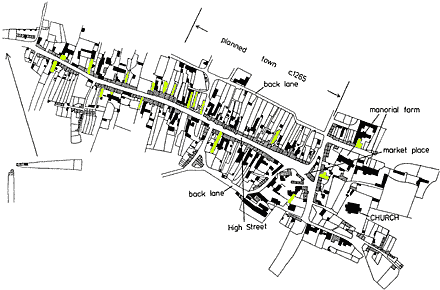

![]()
malting
The 19 malthouses of Marshfield at the beginning of the 18th century. Compare this with a map of the pubs.
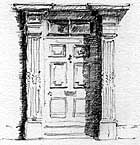 |
door of 78 High Street 'The Malting House' -- the last Marshfield malthouse, drawn by David Fisher (see photograph, below) |
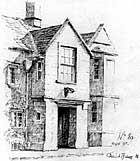 |
entrance to 80 High Street, another former malthouse, drawn by David Fisher -- note the peephole at the side, designed to keep a look out for the excise men (see photograph, below) |
malting in Marshfield
The primary source for this article was 'Malting at Marshfield' Bristol Industrial Archaeological Journal, 1990, 22:4-11
It was probably the high quality of the barley that could be grown on the shallow soils of the southern Cotswold uplands, on which Marshfield is located, that led to the early development of the town as a malting centre.
malting
In the production of beer, malted grain -- usually barley, but
other types of grain can be employed -- provides a fermentable
sugar to make alcohol and gives some of the flavour. Raw grain
contains a high proportion of starch as a food reserve for the
germinating plant, but before it can make use of this, the starch
has to be converted into sugar by enzyme action. Malting takes
advantage of this natural process.
The grain is steeped in water in a vat, and then the damp grain is spread on a floor and encouraged to germinate and develop until the majority of its starch has been converted to sugar. At this crucial point, the sprouting grain is spread on a special floor made of tiles covered in perforations large enough so that air from a kiln can flow through them but small enough so that the grain will not fall through. The heated air from the kiln stops the sprouting and dries and preserves the grain at this stage in its development, when it is full of malt sugar. The 'malt' would then be taken to a brewery, where it would be ground up and used in the production of beer.
maltmen and malthouses
Malting has existed in Marshfield since at least the 15th century.
On 19 November 1458, a pardon of outlawry was granted to Richard
Porter of Marshfield -- described as a 'maltman' -- for not appearing
at court on a charge of trespass. Of the 147 adult males recorded
in the town in 1608, 22 -- that is, 15% of the total -- were maltmen.
In addition, there are a number of deeds, some dating back to
the 18th century, for houses that include malthouses as well as,
frequently, breweries near the properties.
The industry probably reached its peak in Marshfield in the 18th century, and so was already in decline at the time of the tithe apportionment of 1841. Nevertheless, the tithe map for Marshfield records 19 malthouses. The industry lasted only another 70 years: the last malting in the town was carried out in about 1920, at No. 78 High Street by Thomas Wayte Knight, the great-grandfather of Dick Knight of Castle Farm.
Malting was a seasonal occupation, carried out after harvest until the following spring, when agricultural duties were less pressing. Marshfield's maltmen were employed on the farms during the summer and harvest or, alternatively, worked at brickmaking.
Even the largest known maltings in Marshfield were carried out on a very small scale. The malthouse was usually attached to a house, frequently with the kiln installed next to the residence to provide warmth during cold weather. In the malthouse, there were generally at least two floors on which the grain could be spread to germinate. These low-ceilinged rooms were ventilated by a series of small openings -- good air circulation rather than light being required -- that were frequently equipped with shutters to allow fine control of air flow. The heated moist air from the drying grain would flow out of the kiln through a characteristic vent in the roof.
malting and the law
In the 17th century, a tax on malt came into force. To assess
the amount due to the government, an excise officer had to measure
the volume of the grain at the start and at the end of the steeping
process. Special containers had to be used by the maltmen to enable
the excise men to carry out their work. One of these -- a temporary
storage bin known as a 'couch frame' -- was filled with steeped
grain awaiting the second measurement. This was disadvantageous
to the maltmen, because the damp grain might be left too long
in an unspread heap and later germination could be erratic.
The former importance of Marshfield as a malting centre is evinced by the fact that two excise officers were frequently present in the town at one time. Peepholes still exist in the porches of some of the houses in the High Street, which were used to watch the movements of the excise men so that the maltmen could be warned of their approach and hide their steeping grain to avoid tax. This tax was finally repealed in 1880.
Photographs of former Marshfield malthouses, taken by James and Robert White.
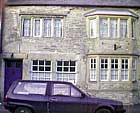
20 High Street
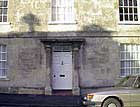
78 High Street (see the drawing above)
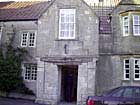
80 High Street (see the drawing above)
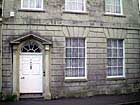
83 High Street, once home to the Englands
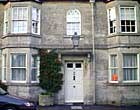
88 High Street
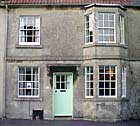
90 High Street
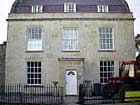
94 High Street
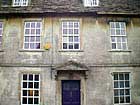
119 High Street
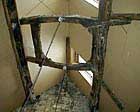
an interior detail of the roof beams -- a structure used to support
the kiln chimney -- at 119 High Street
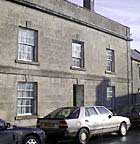
126 High Street

140 High Street
Back to history
